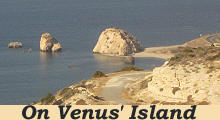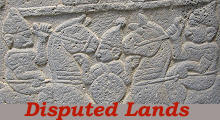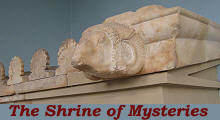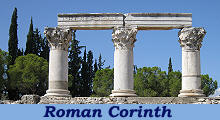

What's New!
Detailed Sitemap
All images © by Roberto Piperno, owner of the domain. Write to romapip@quipo.it. Text edited by Rosamie Moore.
Page added in November 2012.
|

 - Paphos: the Mosaics - Paphos: the Mosaics
(Petra to Romiou, where Venus was born)
Systematic excavations carried out after 1962 in the archaeological area of Paphos led to the discovery of a group of large houses which testify to the wealth of the town in the IInd/IIIrd centuries AD when it was the residence of the Roman governor.
House of Theseus: (left) mosaics; (right) baths
Archaeologists were able to identify courtyards, reception halls, baths and other facilities of the houses, but only the lowest parts of their walls.
Columns and lintels were probably moved elsewhere after Paphos was hit by two strong earthquakes in 332 and 342 AD. However the excavations revealed
large and almost intact mosaics which are at the same time a work of art and a documentation of many aspects of life on Cyprus during the Roman Empire.
The houses are named after the subject of mosaics found there.
House of Theseus: main mosaic (late IIIrd century)
The Romans had a practice of establishing colonies in newly acquired territories in order to strengthen their control over them.
This did not occur on Cyprus where Greek remained the only written language and it was used for the names of the personages portrayed in mosaics. This was done even when they were clearly identifiable as in the mosaic portraying Theseus slaying the Minotaur. The scene is surrounded by a geometric mosaic representing the Labyrinth of Knossos. Of particular interest is the way the Minotaur was portrayed by showing only a gigantic and threatening bull's head (blue dot).
House of Theseus: Achilles' Bath (early Vth century)
The House of Theseus was very large and part of it continued to be used after the earthquakes. A reception room was decorated with a mosaic which illustrates the transition from the Roman/Pagan world to the Byzantine/Christian one. The subject is taken from the Greek myth: Thetys bathed baby Achilles in the River Styx to make him immortal (but she held him by a heel).
The pictor musivarius, as the Romans called the mosaicist in charge of portraying the most complex scenes, chose instead to represent a very domestic event, most likely the family of the owner of the house watching the bathing of a baby. The family head was portrayed as Peleus, Achilles' father, but at the same time as a Byzantine governor (or even emperor), holding a sceptre and dressed in a crimson robe, another sign of command. In the traditional pagan iconography goddesses were portrayed naked,
but Thetys and her housemaids wear long robes as nakedness had a negative connotation in the Christian world.
House of Aion: main mosaic (mid IVth century AD)
Aion or Eon is a god, perhaps of Phoenician origin, who entered the Greek/Roman pantheon in the IInd century AD.
Aion was associated with Eternal Time and represented as a youth holding a circle. The main mosaic found in the House of Aion depicts a series of scenes which focus on Dionysus, a god with many facets whose cult spread throughout the whole Roman Empire and was associated with initiation rites.
House of Aion: Birth of Dionysus
Syncretism is the combining of different beliefs, traditions with the underlying objective to show that apparent contradictions can be solved and substantial unity can be achieved. When this mosaic was made roughly half of the population of the Roman Empire had embraced the Christian faith and the other half was still attached to traditional beliefs. By eliminating the wings on the head of Hermes (Mercury) and by changing the names of the personages this mosaic could represent the Nativity of Jesus.
House of Aion: Apollo and Marsyas
The traditional iconography of Apollo playing a lyre portrayed the god as a naked youth, occasionally with slightly womanish features. In the IInd century AD some mosaics showed Apollo with a radiant sun surrounding his head. In this mosaic Apollo is fully clothed and the radiant sun has become a glowing halo, whereas Marsyas is depicted as a barbarian and the men carrying him away wear a Phrygian cap, the same worn by Mithras, a god of Persian origin. It is therefore likely that, although formally depicting Apollo and Marsyas, the mosaic had other metaphoric meanings.
House of Aion: Leda and her housemaids
Other sections of the same large mosaic are more in line with traditional iconography and they show better quality. Perhaps the mosaicists who were active at Paphos came from Antioch on the mainland opposite Cyprus, which was one of the largest cities of the Roman Empire. While there is almost no remaining evidence of the ancient city, many splendid mosaics have been found in its environs and can be seen in a page dedicated to the Museum of Antiochia.
House of Aion: (left) detail of a Dionysiac procession; (right) Thetys
Philippopolis (today's Shahba in southern Syria) retains several mosaics which have points in common with those found at Paphos. In particular a Toilet of Aphrodite shows the goddess with the halo and with a mantle above her head similar to those worn by Thetys and other nymphs at the House of Aion. Similar mantles, an attributes of nymphs and goddesses, can be seen on the relief of Saturnia Tellus at Ara Pacis Augustae in Rome.
House of Dionysus (mainly IInd century AD): (left) a series of mosaics; (right) a detail showing one of the Dioscuri, the twin horsetamers worshipped by the Romans
The mosaics of this house are a sort of museum in the sense that most types of mosaics and of subjects are represented. A more appropriate name for the house could be the House of Love and Death because of the scenes portraying popular ill-fated love stories.
House of Dionysus: Pyramus and Thisbe
Pyramus and Thisbe, he the loveliest youth, and she the most sought after girl the East held, lived in neighbouring houses, in the towering city of Babylon.(..) They decided (..) to try, in the silence of night, to deceive the guards, and vanish outside. Once out of the house they would leave the city as well, and they agreed, in case they went astray crossing the open country, to meet by the grave of Ninus, and hide in the shelter of a tree. There was a tall mulberry tree there, dense with white berries, bordering a cool fountain.
(..) Carefully opening the door, Thisbe, slipped out, deceiving her people, and came to the tomb, her face veiled, and seated herself under the tree they had agreed on. Love made her brave. But a lioness fresh from the kill, her jaws foaming, smeared with the blood of cattle, came to slake her thirst at the nearby spring. In the moonlight, Thisbe sees her some way off, and flees in fear to a dark cave, and as she flees, she leaves behind her fallen veil. When the fierce lioness has drunk deeply, returning towards the trees, she chances to find the flimsy fabric, without its owner, and rips it in her bloodstained jaws.
Leaving the city a little later, Pyramus sees the creature’s tracks in the thick dust, and his face is drained of colour. When he also discovers the veil stained with blood, he cries, “Two lovers will be lost in one night. She was the more deserving of a long life. I am the guilty spirit. I have killed you, poor girl, who told you to come by night to this place filled with danger, and did not reach it first. O, all you lions, that live amongst these rocks, tear my body to pieces, and devour my sinful flesh in your fierce jaws! Though it is cowardly to ask for death”.
He picks up Thisbe’s veil, and carries it with him to the shadow of the tree they had chosen. Kissing the token, and wetting it with tears, he cries, “Now, be soaked in my blood too.” Having spoken he drove the sword he had been wearing into his side, and, dying, pulled it, warm, from the wound. As he lay back again on the ground, the blood spurted out, like a pipe fracturing at a weak spot in the lead, and sending long bursts of water hissing through the split, cutting through the air, beat by beat. Sprinkled with blood, the tree’s fruit turned a deep blackish-red, and the roots, soaked through, also imbued the same overhanging mulberries with the dark purplish colour.
Now Thisbe returns, not yet free of fear, lest she disappoint her lover, and she calls for him with her eyes and in her mind, eager to tell him about the great danger she has escaped. Though she recognises the place and the shape of the familiar tree, the colour of the berries puzzles her. She waits there: perhaps this is it. Hesitating, she sees quivering limbs writhing on the bloodstained earth, and starts back, terrified, like the sea, that trembles when the slightest breeze touches its surface, her face showing whiter than boxwood. But when, staying a moment longer, she recognises her lover, she cries out loud with grief, striking at her innocent arms, and tearing at her hair. Cradling the beloved body, she bathes his wounds with tears, mingling their drops with blood. Planting kisses on his cold face, she cries out ‘Pyramus, what misfortune has robbed me of you? Pyramus, answer me! Your dearest Thisbe calls to you: obey me, lift your fallen head!’ At Thisbe’s name, Pyramus raised his eyes, darkening with death, and having looked at her, buried them again in darkness. When she recognised her veil and saw the ivory scabbard without its sword, she said, “Unhappy boy, your own hand, and your love, have destroyed you! I too have a firm enough hand for once, and I, too, love. It will give me strength in my misfortune. I will follow you to destruction, and they will say I was a most pitiful friend and companion to you. He, who could only be removed from me by death, death cannot remove. Nevertheless I ask this for both of us, in uttering these words, O our poor parents, mine and his, do not deny us the right to be laid in one tomb, we whom certain love, and the strangest hour have joined. And you, the tree, that now covers the one poor body with your branches, and soon will cover two, retain the emblems of our death, and always carry your fruit darkened in mourning, a remembrance of the blood of us both.”
Saying this, and placing the point under her heart, she fell forward onto the blade, still warm with his blood. Then her prayer moved the gods, and stirred her parents’ feelings, for the colour of the berry is blackish-red, when fully ripened, and what was left from the funeral pyres rests in a single urn.
Ovid - Metamorphoses - Book IV - Translation by A. S. Kline.
House of Dionysus: Apollo and Daphne
Apollo was not invariably successful in love. On one occasion he pursued Daphne, a mountain nymph and a priestess of Mother Earth; but when he overtook her, she cried out to Mother Earth who, in the nick of time, spirited her away to Crete and left a laurel-tree in her place, and from its leaves Apollo made a wreath to console himself.
From Robert Graves - The Greek Myths.
House of Dionysus: Hippolytus and Phaedra. Hippolytus is astonished when he reads the message Phaedra sent him. She is anxiously waiting for the young man's reaction to her proposal
If your ears have heard anything of Hippolytus, of how, through his father’s credulity, and the deceits of his accursed stepmother, he met his death, though you will be amazed, and I will prove it with difficulty, nevertheless, I am he.
Phaedra, Pasiphaë’s daughter, having tried, vainly, to tempt me to dishonour my father’s bed, deflected guilt, and, (more through fear than anger at being rejected?), made out I had wanted, what she wished, and so accused me. Not in the least deserving it, my father banished me from the city, and called down hostile curses on my head.
Ovid - Metamorphoses - Book XV - Translation by A. S. Kline.
House of Dionysus: hunting scenes
The art of mosaic was not restricted to the Levant. Another school of skilled mosaicists developed in the Roman province of Africa. You may wish to see a section showing mosaics in today's Libya and another one covering today's Tunisia.
The image used as background for this page shows a mosaic portraying Orpheus taming the beasts in the House of Orpheus.
House of Dionysus: geometric mosaic
Return to page one.
Move to:
Introductory Page
Amathous and Kition
Kourion
Salamis

SEE THESE OTHER EXHIBITIONS (for a full list see my detailed index).
  
|